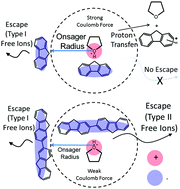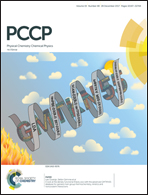Escape of anions from geminate recombination in THF due to charge delocalization†
Abstract
Geminate recombination of 24 radical anions (M˙−) with solvated protons (RH2+) was studied in tetrahydrofuran (THF) with pulse radiolysis. The recombination has two steps: (1) diffusion of M˙− and RH2+ together to form intimate (contact and solvent separated) ion pairs, driven by Coulomb attraction; (2) annihilation of anions due to proton transfer (PT) from RH2+ to M˙−. The non-exponential time-dependence of the geminate diffusion was determined. For all molecules protonated on O or N atoms the subsequent PT step is too fast (<0.2 ns) to measure, except for the anion of TCNE which did not undergo proton transfer. PT to C atoms was as slow as 70 ns and was always slow enough to be observable. A possible effect of charge delocalization on the PT rates could not be clearly separated from other factors. For 21 of the 24 molecules studied here, a free ion yield (71.6 ± 6.2 nmol J−1) comprising ∼29% of the total, was formed. This yield of “Type I” free ions is independent of the PT rate because it arises entirely by escape from the initial distribution of ion pair distances without forming intimate ion pairs. Three anions of oligo(9,9-dihexyl)fluorenes, Fn˙− (n = 2–4) were able to escape from intimate ion-pairs to form additional yields of “Type II” free ions with escape rate constants near 3 × 106 s−1. These experiments find no evidence for an inverted region for proton transfer.

- This article is part of the themed collection: 2017 PCCP HOT Articles


 Please wait while we load your content...
Please wait while we load your content...